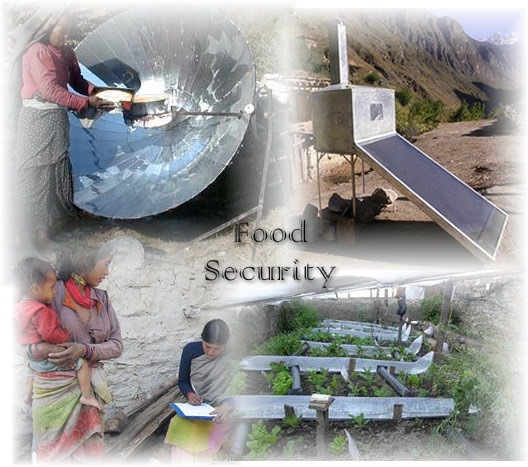| Food Security |
 |
 |
 |
|
In terms of energy, traditional fuel consumption (mainly wood) represents 93% of total usage but in the remote and improvised mountain areas, it represents 100% of total usage. The average per capita electricity consumption is only 91 kWh per annum, although electricity is only accessible to approximately 25% of the nation's population. Infant mortality, compared to developed nations, is high ranging from 86 to 53 per 1000 live births for the poorest and richest 20% respectively. The UNDP estimates that in 2001-3, 17% of the population was estimated to be malnourished. In children under five years old, this was reflected in 48% and 51% being under weight and under height for age respectively. Over one fifth of babies were born underweight. These average statistics, alarming as they are, mask a more serious situation for rural and remote people in Nepal, where malnutrition and its effects are much worse. Food Security in HumlaThe World Bank defines 'food security' as "access by all people at all times to enough food for an active healthy life" (NPC/UNDP, 2005). Humla has been judged to be one of the poorest. Using a ranking of 1 (best) to 75 (worst), Humla was ranked 74th in the overall index in regard to poverty, deprivation, socioeconomic and infrastructural development, and women's empowerment (ICIMOD, 2003). In this food deficient area, a subsistence economy runs on inter-village trade, livestock and the cultivation of food-grains". Less than one percent of the land is arable due to steep slopes, rocks, rivers and forest cover (DPH, 2004) and snow cover for five months of the year reduces fresh food production to just 3-4 months per year. As a result, and unsurprisingly, there is chronic malnutrition among the local population. In a study of children in the districts of Humla found that malnutrition rates of children below 5 yrs old is 65%.
RIDS-Nepal recognized this problem plaguing the people of Humla and started to fight back by developing different projects that would help the people there in this enormous problem. RIDS-Nepal has developed 5 different programs to address this issue which includes Smokeless metal stove , Solar Cooker , Solar Drier , Greenhouse and Nutrition Programmme .  All of these programs are specifically designed to increase the overall food production, reduce the food scarcity, cook and store the available food effectively and hygienically and teach how children should be taken care of by providing the necessary daily nutrients. You can take a closer look at each of the individual programs through Food Security menu. |
 Nepal is a developing country and is ranked 142 out of 177 countries in terms of Human Development Index (UNDP, 2007). The UNDP also ranks Nepal as 68th out of 102 developing countries with an annual GDP per capita of US$ 252 (UNDP, 2006). In 2006, the country had an estimated population of 28.3 million (CIA, 2007), of which 40% were aged 15 or less; approximately 80% of the population lived in rural areas.
Nepal is a developing country and is ranked 142 out of 177 countries in terms of Human Development Index (UNDP, 2007). The UNDP also ranks Nepal as 68th out of 102 developing countries with an annual GDP per capita of US$ 252 (UNDP, 2006). In 2006, the country had an estimated population of 28.3 million (CIA, 2007), of which 40% were aged 15 or less; approximately 80% of the population lived in rural areas.